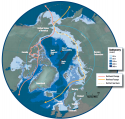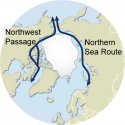A bit of Russian shipbuilding news, as local Zvezda shipbuilder gets contract to build 14 state of the art Arc7 ice breaking LNG carriers.
Two new Yamal LNG carriers coming down the pike. One is the LNG Phecda, owned by Mitsui OK and COSCO, built by Hudong Zhonghua.
These ships are strategically important for Russia's energy industry.
View attachment 63298
A bit off topic but educational as we are seeing a resurrection of the Russian shipbuilding industry. Zvezda Shipyard is Russia's new shipbuilding champion, and it has recently completed a 485 meter long drydock in the Russian Far East. That's about like any of the Asian drydocks you see in China, S. Korea and Japan that are used to pound out 400 meter long ships.
- Zvezda Shipbuilding complex is finishing dry dock construction
Construction of dry docks, one of the largest world, at Zvezda Shipbuilding complex is coming to an end, Rosneft says in a press release. Pre-commissioning operations are in progress. The unique hydraulic engineering installations measuring 485 by 114 by 14 metres creates unlimited possibilities for construction of ships of any possible size and complexity. The dry dock will be commissioned 4 years ahead of the scheduled time.
At the moment Zvezda specialists in cooperation with Federal Environmental Industrial and Nuclear Supervision Service of Russia (Rostechnadzor) and the Department of State Expertise are testing the dry dock and the facility’s equipment to ensure readiness of machines and mechanisms for work. Previously, in order to control the filter system of the hydraulic engineering installations, the dry dock was filled with water. The floating dock gate has been winded and installed. It separates the dock chamber, the bottom of which is below the water level, from the sea waters. The technological shutter was delivered to the dock in order to split the dock area into separate independent boxes in order to build several ships at once. The dock was equipped with 4 crane towers with lifting capacity of 60 tonnes each and the Goliath gantry crane with lifting capacity of 1,200 tonnes. Pre-commissioning operations are in progress.
Zvezda Shipbuilding complex is being constructed by in the Far East by the Rosneft-led investor Consortium upon the instruction of President of Russia Vladimir Putin. The following facilities have already been put into operation on Zvezda Shipbuilding complex: the hull production workshop, painting booths, the open heavy outfitting slipway equipped with a park of unique cranes and a state-of-the-art ship transportation system, and the floating transfer dock. The workshops built made it possible to start the construction of a number of ships before the completion of the second stage.
At the moment the Shipyard's order portfolio amounts to over 40 vessels - 59 vessels including options. The Shipyard's pilot throughput is provided by Rosneft that placed an order for 28 vessels. Zvezda’s product line will include vessels of up to 350 tonnes displacement, components of marine platforms, ice-class vessels, commercial vessels for cargo transportation, specialty vessels, and other types of marine equipment of any complexity, characteristics and purposes, including those that had not previously been produced in Russia due to the lack of required launching and hydraulic structures.
Zvezda Shipbuilding Complex will rival foreign shipyards and provide Russia with a civil fleet to develop offshore fields and smoothly operate the Northern Sea Route--the shortest route between Europe and Asia.
Such a drydock can help Russia build a Nimitz sized aircraft carrier, potentially, however there is already a long list of ships to build for customers.
The Northern Sea Route --- from the Arctic Ocean, through the Bering Straits and down to the Pacific --- is going to become strategically important for China-Russia oil relations, and it can also be a shortened route delivering goods to Europe, instead of passing to the south at the Malacca Straits, to the Indian Ocean, and up the Suez. The Southern Indian Ocean route can be threatened by Australia and India, and is bottle necked at the Malacca Straits, the Red Sea, and the Suez Canal.
To support both North and Northwest Passage routes, China should look more into building more ice breaking capable ships such as ARC 7 ships.












